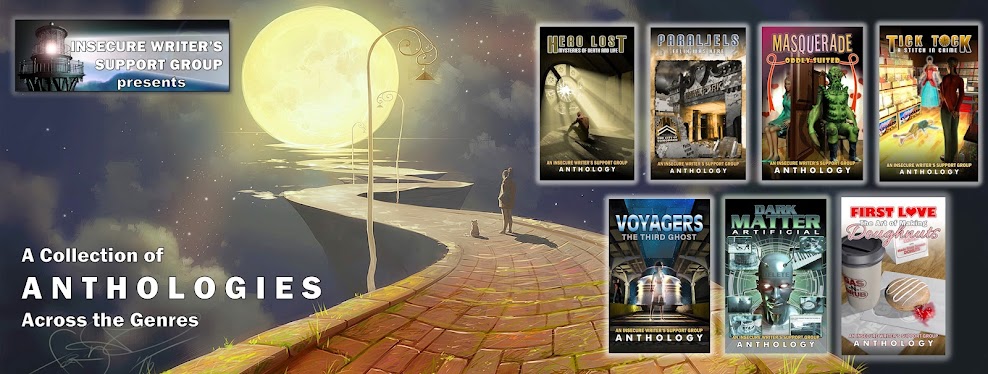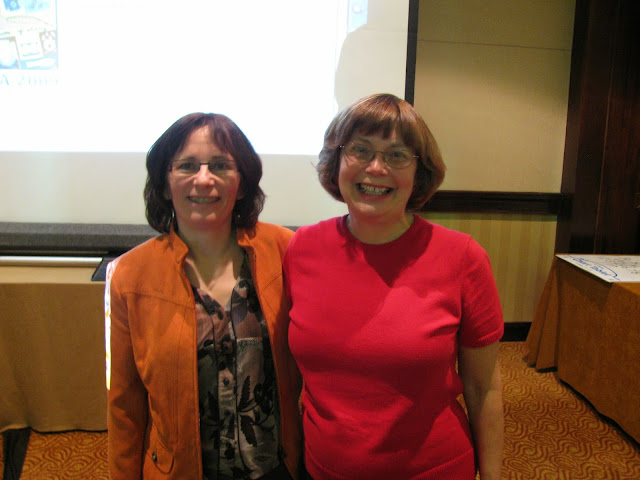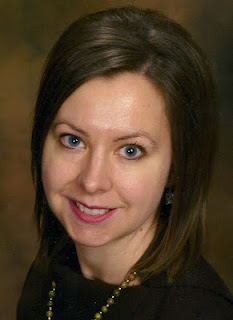Congratulations, you have written and published a children's book!
Now comes the hard part, promoting and selling your book.
"My" Book ~ The Anthology Containing My Short Story
"Dare Double Dare"
One way to do this is to create a user-friendly teacher's guide
that you can use during school and library visits, in presentations
at conferences, or as an exhibiter at industry events.
Yes, it's fun to share your book with children,
but make your book user-friendly for teachers
and they will buy copies to use in their classrooms.
Also, parents who homeschool their children
will appreciate a good book with an easy-to-use guide.
I know. I taught elementary students for twenty-five years,
and I bought hundreds and hundreds of children's books
to use for reading aloud, small groups, and whole class instruction.
I was constantly looking for good children's fiction and non-fiction
that I could use in all areas of my elementary curriculum.
When I found a good book, I would buy ten copies for small group use
or twenty-five books for a classroom set. This was easier for me
than having a number of children share a book or assembling
a classroom set by borrowing copies from multiple libraries.
A teacher's most valuable
resource is time.
I quickly learned that a good teacher's
guide saved me lots of time
with its useful information
and ready-to-use activities.
Writing a teacher's guide need not be intimidating.
You can start small and go from there.
I'll start small by giving you the basic tools to create a reproducible handout
as a teacher's guide. This is easier and more cost-effective than a 32-page teacher's guide for publication. Once you have this handout, you can decide if you want to invest the time, effort, and money in publishing a teacher's guide. Meanwhile you have a guide you can use in the short-term while you go big and create a guide for publication.
Authors have used such handouts during presentations at schools, libraries, bookstores, and conferences, and I found them useful as a teacher. My sister Roberta and I have created these handouts and used them to promote her published books. For this teacher utility beats gloss every time.
Bertie (left) and I Presenting at CCIRA
(Colorado Council of the International Reading Association)
Denver, Colorado
February 2011
© M. Louise (MacBeath) Barbour/Fundy Blue
All Rights Reserved
Let's Get Started!
There are several steps to take before writing your teacher's guide:
1. Check your publishing contract and with your publisher to verify what material you can use from your book and how. For example, with Voyagers,
my fellow authors and I may quote an excerpt up to 1,000 words in length to use in social media and other places to promote the book. We can also use photographs, images, and other materials provided by our publisher. Otherwise, we are free to create and promote as we choose. Different publishers will have different requirements, so be sure to check. Of course,
all publishers want you to promote your books!
An Image for My Short Story
Provided by My Publisher
to Promote Voyagers
2. Decide how much time, effort, and money you are willing to invest in creating a teacher's guide.
a) Jackpot: If you land a publishing contract with a traditional publisher,
they may publish a teacher's guide for you or publish your written guide
and sell it with your book in bookstores and education stores. Your publisher
may also publish an on-line teacher's guide for you.
Here's an on-line example: Penguin
(https://www.penguin.com/school-library/teaching-guides-activity-kits/)
Additionally, another company may publish a teacher's guide for your book. Pictured below is a teacher's guide that I bought near the beginning of my career for Sylvester and the Magic Pebble by William Steig, a book I used
over and over along with the guide.
A Resource I Used Over and Over as a Teacher
Photo by Louise MacBeath Barbour
b) Farm It Out: Let's face it. Not all authors land a publishing contract
with a publisher who will publish a teacher's guide for their book.
Another option is to hire someone to write a teacher's guide for you.
Here's an example of such a service I found on-line:
(This is an example only, not a recommendation one way or another.)
Marcie Colleen (http://www.thisismarciecolleen.com/teachers-guides.html)
c) Do It Yourself: Many of us will choose this option. If you do, keep reading.
3. Next, determine what grades your book is suitable for.
There are several ways you can do this: ask a teacher or librarian,
visit a bookstore or education store and compare your book with
grade-leveled books, or search on-line for grade-leveling applications.
One calculator I have used a lot is the Fry Graph Readability Formula
(https://readabilityformulas.com/fry-graph-readability-formula.php).
A source with additional ideas is Wiki How
(https://www.wikihow.com/Determine-the-Reading-Level-of-a-Book).
As a teacher I know that many classrooms contain students with a wide
range of reading abilities, from students who are reading at grade level
to students who are gifted, have learning disabilities or other challenges,
and English language learners. Your book may be suitable for a number
of grades depending upon how a teacher uses it.
4. Check out the education standards for your book's grade levels.
Teachers throughout the United States are accountable for their students
meeting grade level standards. Student performance is measured by
state-mandated assessments. Preparing students to meet these standards
and take these assessments makes huge demands on a teacher's time.
Including the appropriate standards in your teacher's guide will save
teachers time and make it more user-friendly.
Most states have adopted the Common Core State Standards,
and the Common Core State Standards Initiative, CCSSI,
is a good source for information on the standards.
CCSSI (http://www.corestandards.org)
You can find the English Language Arts Standards here
(http://www.corestandards.org/ELA-Literacy/)
and find your state standards by clicking on your state on the map here.
(http://www.corestandards.org/standards-in-your-state/).
States that have not adopted the Common Core State Standards
will have their standards posted on-line. For example, google
"Texas State Education Standards" and you'll find the site.
Writing Your Guide:
1. Start Small: As I suggested earlier, start small by creating a reproducible handout as a teacher's guide, especially if this is your first attempt. You can always go big later.
2. What to Include: Again, this is a starting point on which you can build.
As a minimum I would include:
a) About the Author: A biography outlining who you are, what you have published, and any other information that you would like to include.
b) Copyright Information:
i. For a teacher's guide handout, state that the handout may be used free of charge for educational purposes and that a teacher may reproduce copies of information and activities to use in his or her classroom. Write "Reproducible" on each page of the teacher's guide suitable for classroom use.
ii. For a published teacher's guide, include standard industry copyright protections. Typically teachers may make copies for educational purposes only and may not use the information or activities for other purposes without written permission from the publisher.
c) Table of Contents: List each section of the teacher's guide with page numbers.
d) Standards:
i. List the English Language Arts Standards for the targeted grades that connect to the activities you have in your teacher's guide. Include the text of the standard, so the purpose of your activity is clear.
ii. If your book can be used in other areas of the curriculum, such as
science, math, or social studies, list the standards for those subject too.
e) Story Summary: Include a brief synopsis of the book
or an introduction to the book that doesn't contain spoilers.
f) Vocabulary List: Include a list of unfamiliar or challenging words
and their definitions that the teacher can use as he or she chooses.
For example, some words that I would put in a vocabulary list for my
short story "Dare Double Dare" are glacial erratic, fleur-de-lis, and disorienting.
g) Pre-reading Activities: Usually teachers will introduce a book with
pre-reading activities to engage students and to increase their background
knowledge about the book's content. These activities should be fun and
motivate the students to read the book. Create four or five activities
so the teacher will have some choices, and connect each activity to an
appropriate educational standard.
Here is a brief example of a pre-reading activity for my "Dare Double Dare."
Whole Class Discussion: Ask the students if they have ever dared someone
to do something or if they have ever taken a dare. Call on students
to share what happened and whether or not the dare was a good idea.
CCSS.ELA-LITERACY.SL.3.1.B
Note:
CCSS.ELA-LITERACY.SL.3.1.B describes a grade-specific common core standard.
CCSS.ELA-LITERACY.SL.3.1.B means "Common Core State Standards.
English Language Arts-Literacy. Speaking & Listening. Grade 3. Standard 1. B."
The actual standard is "Follow agreed-upon rules for discussion (e.g., gaining the floor in respectful ways, listening to others with care, speaking one at a time about the topics and texts under discussion)."
CCSSI (http://www.corestandards.org/ELA-Literacy/SL/3/)
This is what I would put in the standards section of my teacher's guide. I would include the short form, CCSS.ELA-LITERACY.SL.3.1.B, with the activity.
Some authors don't like being as specific with standards when writing a teacher's guide. However, a teacher would appreciate the connection of an activity with a standard.
h) Reading Activities: A teacher chooses a book to use in the classroom thoughtfully, considering the abilities and interests of the students, the quality, content, and length of the book, and the requirements of the curriculum and standards. Then he or she plans lessons to meet instructional goals. For example, "Dare Double Dare" is one story in Voyagers, a book with adventurous tales appealing to middle grade readers. The stories span the globe, time, and cultures, giving a teacher the opportunity to differentiate instruction in small groups and to use it across the curriculum, especially in social studies and history. As a teacher, I would choose a story to read aloud to the whole class to introduce the book and to provide the class with a common experience. Then I would branch out from there with other stories and reading activities appropriate for the instructional goals for my individual students.
CCSS.ELA-LITERACY.RL.3.10
i) Post-reading Activities: Following up reading a text with post-reading activities helps students organize their ideas, summarize what they have learned, and check their understanding. The scope of possible activities is huge and can encompass other subjects in the curriculum, such as writing, math, science, history, and social studies.
Here's an example of a post-reading writing activity for "Dare Double Dare."
Individual Writing: Write the first draft of an opinion piece for the writing prompt "If you could travel in time, when and where would you like to go? Why?"
CCSS.ELA-LITERACY.W.3.1.B
j) Bibliography with Notes: A bibliography containing print and on-line resources for teachers is a user-friendly resource. Adding notes can increase its usefulness. My short story in Voyagers includes characters who are French explorers and others who are Miꞌkmaq, and its setting is the Habitation at Port-Royal in Nova Scotia in 1605. I would list resources for teachers and students and add explanatory notes.
k) Information on How to Purchase Your Book: See an example for Voyagers at the end of this post.
3. Go Big: After creating a teacher's guide handout, you may decide to write and publish a teacher's guide for your book, or perhaps you would rather skip the handout and go straight to publishing a teacher's guide. Either way, I recommend that you visit bookstores and education stores or search on-line for teacher's guides to review. This process will give you a sense of the range of possibilities and inspire you to create a teacher's guide that works best for your book.
If you live in the Denver area, as I do, I suggest that you visit the Tattered Cover and the Bookies bookstores. If not, as authors, I bet you know all the great bookstores in your area!
Here are some good on-line resources to help you get started:
(https://carolhurst.com)
(https://www.hmhbooks.com/chrisvanallsburg/index.html)
(https://www.mthclassroomadventures.org)
Now Go Write That Teacher's Guide!
What to Do in the Time of Covid:
Currently we don't know when and how our schools will open. One thing for sure is they won't operate as they have in the past. Also, some libraries and bookstores are closed, and conferences and industry events are canceled or postponed. What's an author to do?
I see this Time of Covid as an opportunity. Like many authors, I am preparing for the time I can physically go to these places again. I am writing a teacher's guide for my short story "Dare Double Dare." As a newly-published author, I am planning a website for my current and future publications. On my website I will have an on-line, downloadable version of my teacher's guide and other resources for educators. And, of course, I am writing! In some ways, I am grateful for this time. Other writers will have different goals, but we can all make the best use of this time and its opportunities.
Coming on Wednesday, August 5, 2020, on Insecure Writer's Support Day:
Chrys Fey will share her newly-released writing craft book Keep Writing with Fey: Sparks to Defeat Writer's Block, Depression, and Burnout. Chrys is the author of the Disaster Crimes Series and an editor for Dancing Lemur Press. She is also a moderator for The Insecure Writer's Support Group Book Club on Goodreads.
Till next time ~
Fundy Blue
* * * * * * * * * *
A Basic Outline for Writing a Teacher's Guide:
Pre-Writing:
1. Check your publishing contract and with your publisher.
2. Decide how much time, money, and effort you will invest in the project.
3. Determine what grades your book is suitable for.
4. Check out the education standards for your book's grade levels.
Write Your Guide:
1. About the Author
2. Copyright Information
3. Table of Contents
4. Standards
5. Story Summary
6. Vocabulary List
7. Pre-reading Activities
8. Reading Activities
9. Post-Reading Activities
10. Bibliography with Notes
11. Information on How to Purchase Your Book
* * * * * * * * * *
Reviews of Voyagers: The Third Ghost:
1. Check out lots of reviews and ratings at Goodreads.
1. Check out lots of reviews and ratings at Goodreads.
You can order a copy of
VOYAGERS: The Third Ghost
at the links below.
Print 9781939844729 $13.95
EBook 9781939844736 $4.99
Juvenile Fiction - Historical / Action & Adventure /
Fantasy & Magic
Fantasy & Magic
Amazon - Print https://www.amazon.com/dp/193984472X/ - Kindle https://www.amazon.com/Voyagers-Third-Ghost-Yvonne-Ventresca-ebook/dp/B083C4WPR5/
Barnes & Noble - https://www.barnesandnoble.com/w/voyagers-yvonne-ventresca/1135912991?ean=2940163430857
























